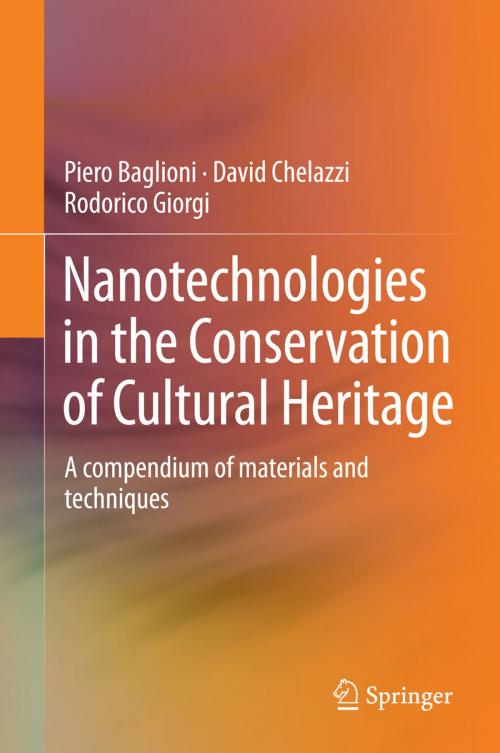Nanotechnologies in the Conservation of Cultural Heritage
A compendium of materials and techniques
Nonfiction, Science & Nature, Technology, Nanotechnology, Social & Cultural Studies, Social Science, Archaeology| Author: | Piero Baglioni, David Chelazzi, Rodorico Giorgi | ISBN: | 9789401793032 |
| Publisher: | Springer Netherlands | Publication: | November 20, 2014 |
| Imprint: | Springer | Language: | English |
| Author: | Piero Baglioni, David Chelazzi, Rodorico Giorgi |
| ISBN: | 9789401793032 |
| Publisher: | Springer Netherlands |
| Publication: | November 20, 2014 |
| Imprint: | Springer |
| Language: | English |
This book presents novel applications of nanotechnology for the preservation of artistic and historical artifacts. It explains the scientific principles behind numerous nanomaterials and discusses their applications to different types of common movable and fixed artistic substrates. It starts with an overview of the nano-tools developed over the last three decades, such as dispersions of nanoparticles, micellar solutions, microemulsions and gels. Compared to traditional methods, these new tools have the benefit of considerably less impact on both the operators and the environment. Each chapter is dedicated to a specific type of cultural heritage material (wall and easel paintings, stone, paper, canvas and wood) starting with the main degradation paths and discussing protocols for the application of innovative nanomaterials-based tools for cleaning, consolidation, or deacidification, which represent the majority of the case studies encountered in restoration facilities, workshops and ateliers. The book provides step-by-step descriptions that are meant to support conservators in the application of these novel materials and methods. The aim of the book is to equip end-users and conservators with essential information and knowledge on the availability and applicability of different nano-materials and dispersed systems. While the book’s focus is on the practical aspects, interested readers will also find references to the relevant advanced colloid and material science literature.
Main audience: Expert conservators, restorers and technical staff at conservation institutes and museums, students at conservation and restoration schools, and scientists who are new to the field of conservation of artistic and historical artifacts.
This book presents novel applications of nanotechnology for the preservation of artistic and historical artifacts. It explains the scientific principles behind numerous nanomaterials and discusses their applications to different types of common movable and fixed artistic substrates. It starts with an overview of the nano-tools developed over the last three decades, such as dispersions of nanoparticles, micellar solutions, microemulsions and gels. Compared to traditional methods, these new tools have the benefit of considerably less impact on both the operators and the environment. Each chapter is dedicated to a specific type of cultural heritage material (wall and easel paintings, stone, paper, canvas and wood) starting with the main degradation paths and discussing protocols for the application of innovative nanomaterials-based tools for cleaning, consolidation, or deacidification, which represent the majority of the case studies encountered in restoration facilities, workshops and ateliers. The book provides step-by-step descriptions that are meant to support conservators in the application of these novel materials and methods. The aim of the book is to equip end-users and conservators with essential information and knowledge on the availability and applicability of different nano-materials and dispersed systems. While the book’s focus is on the practical aspects, interested readers will also find references to the relevant advanced colloid and material science literature.
Main audience: Expert conservators, restorers and technical staff at conservation institutes and museums, students at conservation and restoration schools, and scientists who are new to the field of conservation of artistic and historical artifacts.













![Cover of the book The Dogmatic Principles of Soviet Philosophy [as of 1958] by Piero Baglioni, David Chelazzi, Rodorico Giorgi](https://www.kuoky.com/images/2012/december/300x300/9789401036269-dEmL_300x.jpg)

